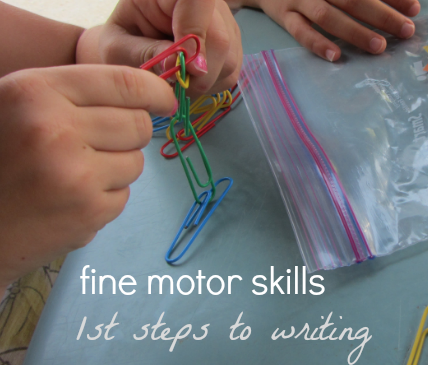Children's fine motor skills—or the small muscle movement of the fingers, hands, and wrists—must be exercised and developed early on in order for kids to meet with success in writing. But how?
Beyond encouraging babies to squeeze fingers, reach for toys, and develop as strong crawlers, fine motor skill development can take some really cool forms.
What can parents do to develop these important little muscles—the muscles that carry a very heavy weight for children's early, foundational educational development? Parents can do a lot. And like a lot of what parents can do from home to build a solid educational foundation, fine motor skill exercises can be disguised as games and play.
Here are some ways that parents can help young children build fine motor skills:
-
Egg Transfer: Using a spoon, have kids transfer a plastic egg or small ball from one bowl to another.
-
Play With Tongs: Kid-friendly tongs can be found just about anywhere. Using tongs, have children move pom-poms or small balls of paper from a bowl to individual sections of an egg carton.
-
Hole Punch: A hand hole-puncher is a great way to build hand muscles. Challenge your child to punch as many holes as he can using one hand—or both!
-
Rubber Bands: The simple act of putting a rubber band onto a baseball bat, golf club, or another medium-sized sturdy object will certainly get those fingers working!
-
Stack and Wrap Coins: Stacking coins and then wrapping them in coin wrappers will not only make for a fun trip to the bank, but it will also work those fine motor muscles!
-
Cutting Practice: Learning how to properly use child-safe scissors is an important skill for school preparedness and for developing hand and finger muscles.
-
Bingo Dauber: Bingo daubers are super first tools for teaching kids how to place a mark in a designated spot. Draw shapes on paper with a pencil or marker and have your child "dot" along the line. She will love it!
-
Stamping: Kids love stamps! Stamping pictures, scenes, and designs will help develop muscles and grow creative children.
-
Play Dough: Rolling, squishing, and flattening play dough, along with making little balls, snakes, or shapes is a super exercise for hand muscles.
- Sticker Stars: Peeling the backs off of stickers and placing the stickers on paper not only ranks high among favorite kid activities, it also works toward developing those important finger muscles!
These ideas are just a start! Think outside the box: using paper clips, writing with tiny, broken crayons, or stringing yarn through dry noodles is all really fun for kids. Fine motor skills can be exercised all through elementary school, but the early years are critical to starting our kids off on the right foot for writing.
What are your favorite ways to help children develop fine motor skills? We'd love to hear them!
Next step: Teaching proper grip!
Share your thoughts on the Scholastic Parents Facebook page, or find Amy on Twitter, @teachmama, and let's continue the conversation!
Read all posts by Amy Mascott.


